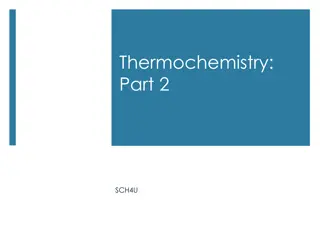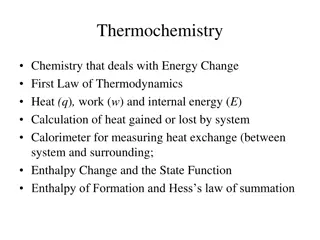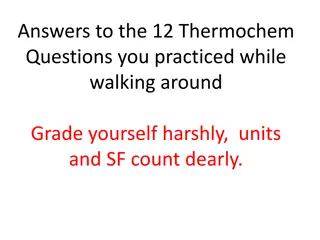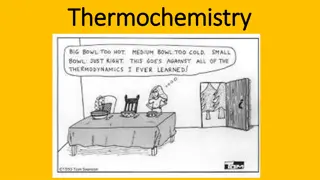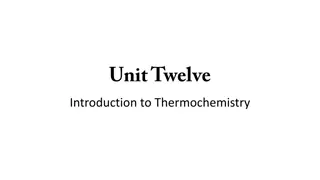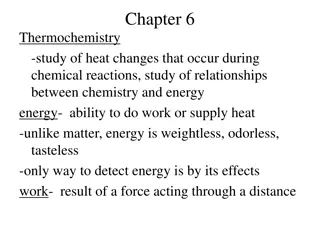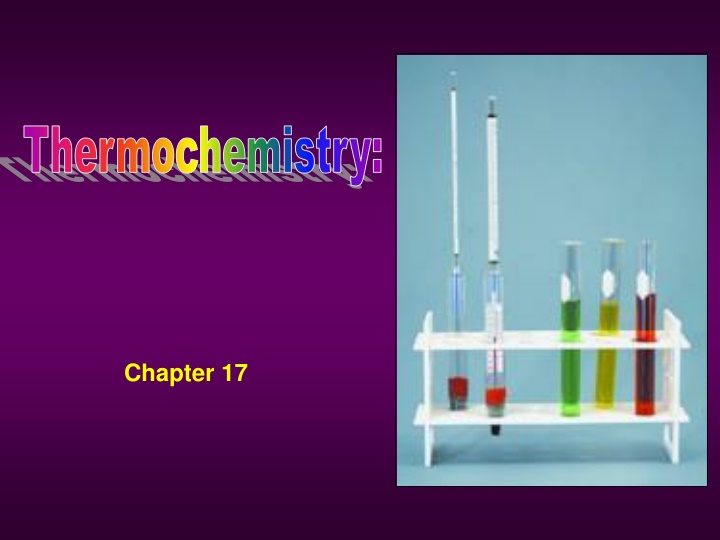
Understanding Thermochemistry and Thermodynamics
Dive into the world of thermochemistry, exploring energy changes in chemical reactions and states, distinguishing between heat and temperature, and learning about the laws of thermodynamics and phase changes. Discover the crucial differences between heat and temperature, the laws governing energy transfer, and how substances transition between phases with varying energy inputs.
Download Presentation

Please find below an Image/Link to download the presentation.
The content on the website is provided AS IS for your information and personal use only. It may not be sold, licensed, or shared on other websites without obtaining consent from the author. If you encounter any issues during the download, it is possible that the publisher has removed the file from their server.
You are allowed to download the files provided on this website for personal or commercial use, subject to the condition that they are used lawfully. All files are the property of their respective owners.
The content on the website is provided AS IS for your information and personal use only. It may not be sold, licensed, or shared on other websites without obtaining consent from the author.
E N D
Presentation Transcript
Thermochemistry: Thermochemistry: Chapter 17
Thermochemisty Thermochemistry Is the study of energy changes that occur during chemical reactions and changes in state Two types of energy to consider: 1. Chemical Potential Energy (PE) Energy Stored in the chemical bonds 2. Kinetic Energy (KE) Energy of motion
Thermodynamics 2 Laws of Thermodynamics (simplified): First Law of Thermodynamics: Energy can neither be created nor destroyed. It can, however, move from one place to another. (Law of Conservation of Energy) Second Law of Thermodynamics: Energy always flows from a more concentrated place to a less concentrated place. (High energy to low energy; high temperature to low temperature)
Heat vs Temperature The misconceptions .
Wealth vs Dollar Heat Energy vs Temperature Heat (Usually in Joules or KiloJoules or calories or Kilocalories) Is a form of energy that flows Always travels from warm areas to cool areas From high kinetic energy areas to low kinetic energy areas Temperature (In Celsius or Kelvin) Is a measure of the average kinetic energy of particles As the average kinetic energy of the particles increases, the temperature increases Heat is not temperature! Temperature is not heat! Misconceptions about heat and temperature .
Heat vs. Temperature Do not use the term heat if you mean temperature! Do not use the term temperature if you mean heat! Unit for temperature (T): C Units for heat (q): Joule (J) (1000 joules = 1 kilojoule) calorie (cal) (1000 calories = 1 kilocalorie) Conversions: 1 cal = 4.184 J
Energy: Heating/Cooling Curve Shows the temperature and energy of a substance over time as it changes from a solid to a gas To increase the temperature we must add energy.
Phase Changes Melting point Solid to liquid : No temperature change until all of the solid changes to a liquid Freezing point Liquid to solid: No temperature change until all of the liquid changes to a solid Melting point and freezing point are the SAME temperature!
Phase Changes Melting point Solid to liquid : No temperature change until all of the solid changes to a liquid Freezing point Liquid to solid: No temperature change until all of the liquid changes to a solid
Heat and Phase Changes Heat and Phase Changes Exothermic Endothermic 1. 1. Condensation Condensation 1. 1. Evaporation Evaporation 2. 2. Freezing Freezing 2. 2. Melting Melting 3. 3. Deposition Deposition What s the Pattern Here? What s the Pattern Here? Those changes that spread molecules out take in heat; those changes that condense molecules give off heat. 3. 3. Sublimation Sublimation Does it take heat to do the process?
Heat Capacity(not as useful) Endothermic: add heat e d Temp. c b a Exothermic: heat released How much heat is needed to raise the temperature of a solid, liquid, or gas? Time Heat Capacity is amount of heat needed to raise the temperature of something 1 C Heat Capacity depends on: 1. How much substance you have (mass) 2. The chemical composition
Specific Heat (capacity) q = m * T * C e d Temp. c b a q = heat m = mass T = change in temp. Cp = specific heat capacity Time Specific heat capacity: is the amount of heat needed to raise the temperature of 1 gram of a substance 1 C a: CpIce = 2.1 J/g C c: CpWater = 4.18 J/g C e: CpWater Vapor = 1.7 J/g C
Specific Heat of Liquid Water
CpIce = 2.1 J/g C CpWater = 4.18 J/g C CpWater Vapor = 1.7 J/g C Specific Heat 1000 J = 1 kJ How much heat is required to change 10.0 g of water from 20.0 C to 50.0 C? 1250 J OR 1.25kJ How much heat is required to change 10.0 g of ice from -30.0 C to -10.0 C? 420. J OR .420 kJ
Following the Flow of H E A T System Exothermic reaction: the system releases heat to the surroundings Exo Exo- - Endo Endo- - therm therm therm therm Endothermic reaction: the system absorbs heat from the surroundings ic ic ic ic Surroundings
Calorimetry Calorimetry: precise measurement of heat flow in or out of the system during a chemical or physical process Two types of heat reactions: 1. Exothermic reaction: the system releases heat to the surroundings The system loses heat The surroundings gain heat (and feel warmer) 2. Endothermic reaction: the system absorbs heat from the surroundings The system gains heat The surroundings lose heat (and feel cooler)
Calorimetry *****Heat GAINED = Heat LOST***** If we can measure one, we have the other! q = m * T * C 1. Calculate heat gained by the water (all others known) 2. Heat gained by the water equals the heat lost by the metal 3. Calculate specific heat of the metal (water) (metal) q = m * T * C
Calorimetry Unknown: specific heat of metal Known: Specific heat of water, Masses of water & metals Measured: change in temperature for water and zinc
Following the Flow of H E A T System Exothermic reaction: the system releases heat to the surroundings Exo Exo- - Endo Endo- - therm therm therm therm Endothermic reaction: the system absorbs heat from the surroundings ic ic ic ic Surroundings
Heat of Fusion/Vaporization Identify each phase and energy type (KE/PE) for sections a through e: e d Temp. c b a How much heat is needed to change a solid to a liquid, or a liquid to a gas? Time The amount of heat needed depends on: 1. How much substance you have 2. The substance itself
Heat of Fusion/Vaporization q = H*mol e d Temp. c b a q = heat mol = moles H = enthalpy (heat content of a system, aka heat/mol) Time Heat of fusion (melting): heat/mole absorbed to melt a substance Section b: Hfus = 6.01 KJ/mole Heat of vaporization (boiling): heat/mole needed to vaporize a substance Section d: Hvap = 40.7 KJ/mole **No temp. change (flat line!)
Heat of Fusion Heat of Fusion (melt): the amount of heat/mole absorbed to melt a solid substance Hfus = +6.01 KJ/mole Ice absorbs 6.01 kJ/mole to melt (+) Heat of Solidification (freeze) : heat /mole lost when a liquid substance freezes (This is the SAME as Heat of Fusion, the negative sign only shows DIRECTION) Hsol = - 6.01 KJ/mole Water loses 6.01 kJ/mole to freeze (-) How much heat is needed to melt 10.0 g of ice? 3.34 kJ = 3,340 J
Heat of Vaporization Heat of Vaporization (boiling): the amount of heat/mole absorbed to vaporize a solid substance Hvap = 40.7 KJ/mole Water absorbs 40.7 kJ/mole to boil (+) Heat of Condensation: heat /mole lost when a liquid substance condenses(This is the SAME as heat of vaporization, the negative sign only shows DIRECTION) Hcond = - 40.7 KJ/mole Steam loses 40.7 kJ/mole to condense (-) How much heat is needed to evaporate 10.0 g of water? 22.6 kJ = 22,600J
Try it on your own Book page 524: #23, 24 Page 535: #55 (a & b only) 23) 144 kJ 24) .19 kJ 55a) 21.0 kJ 55b) 18 kJ
Putting it all together 1. How much TOTAL heat is needed to melt 10.0 g of water, heat it until boiling, and then vaporize all 10.0 g of water? This question requires multiple parts. We are going to identify those parts, then add them all together!
Putting it all together 1. How much TOTAL heat is needed to melt 10.0 g of water, heat it until boiling, and then vaporize all 10.0 g of water? Melting water uses what equation?(b) Heating water uses what equation?(c) Boiling water uses what equation?(d)
Putting it all together 1. How much TOTAL heat is needed to melt 10.0 g of water, heat it until boiling, and then vaporize all 10.0 g of water? q = H *mol q =m * c* T q = H * mol
Putting it all together 1. How much TOTAL heat is needed to melt 10.0 g of water, heat it until boiling, and then vaporize all 10.0 g of water? Knowns: 10.0g (convert to moles!) & 6.01kJ/mol Knowns: 10.0g, change in T, & 4.18j/goC Knowns: 10.0g (convert to moles!) & 40.7 kJ/mol
Putting it all together 1. How much TOTAL heat is needed to melt 10.0 g of water, heat it until boiling, and then vaporize all 10.0 g of water? Calculate: 3.34 kJ Calculate: 4180J Calculate: 22.6kJ Add up**: 30.12kJ or 30,120J **You must make sure all energies are in the same unit! (1000J = 1kJ)***
Thermochemical Calculations Things to remember Use the appropriate equations for the appropriate parts of the problem Make sure to use the appropriate specific heat values (such as for water vapor) When adding up the energies, be sure to make all of the units the same
Practice on your own How much heat is required to raise the temperature of 25.0g of water from 15.0oC to 135oC? (Hint: think about if you will move through a phase change AND what Cp value(s) you will use!)
How much heat is required to raise the temperature of 25.0g of water from 15.0oC to 135oC? e d Temp. c b a Time
Practice on your own How much heat is required to raise the temperature of 25.0g of water from 15.0oC to 135oC? (Hint: think about if you will move through a phase change AND what Cp value(s) you will use!) 8880 J 56.5 kJ 1490 J 66.9 kJ
Heat of Reaction Thermochemical Equation Contains the enthalpy (heat) change when a chemical reaction takes place Can be written 2 ways: CaO(s) + H2O(l) or CaO(s) + H2O(l) Ca(OH)2 (s) + 65.2 KJ (exothermic) Ca(OH)2 (s) H = - 65.2 KJ **The system is GIVING OFF or GIVING AWAY 65.3KJ, so the change to the system is - 65.2KJ!!!!
Heat of Reaction Practice Problem Thermochemical Equation CaO(s) + H2O(l) Ca(OH)2 (s) + 65.2 KJ (exothermic) or CaO(s) + H2O(l) Ca(OH)2 ( s) H = - 65.2 KJ 1) Calculate the amount of heat (in kJ) released when 2.53 moles of CaO react. 164 kJ 2) Calculate the amount of moles of water needed to produce 86.9kJ of energy. 1.33 mol
Heat of Reaction Practice Problem Thermochemical Equation 2 NaHCO3 + 129kJ Na2CO3 + H2O + CO2 1) Rewrite this reaction in the other format 2 NaHCO3 Na2CO3 + H2O + CO2 H = 129kJ 2) Calculate the amount of heat required to decompose 2.24 mol of NaHCO3 144 kJ
Heat of Reaction Review (ENDOTHERMIC) AB + XY + Energy AB + XY AY + XB H = + energy (EXOTHERMIC) AB + XY AY + XB + Energy AB + XY AY + XB H = - energy AY + XB **Energy can be used is mole ratio calculations**
Heat of Combustion Heat of combustion (similar to heat of reaction): Is the heat of reaction produced from burning 1 mole of a substance Combustion of natural gas (methane) CH4 + 2O2 CO2 + 2H2O + 890KJ or CH4 + 2O2 CO2 + 2H2O H = - 890KJ Combustion of glucose C6H12O6 + 6O2 6CO2 + 6H2O + 2808KJ
Heat of Solution (p. 525) Heat of solution(similar to heat of reaction) Is the heat produced or absorbed during the formation of a solution The enthalpy change caused by dissolving one mole of a substance is the molar heat of solution ( Hsol) **This works just like heat of reaction problems**
Heat of Solution Exothermic reaction Produces heat Heat exits the calorimeter (exothermic) Is a negative number (products have less energy than the reactants) NaOH(s) Na+(aq) + OH-(aq) H(sol) = 445.1KJ/mol The reaction is giving off 445.1 KJ/mol - J
Heat of Solution Endothermic reaction Requires heat energy from the environment to get reaction to run Heat enters the calorimeter (endothermic) Is a positive number: products have more energy than reactants NH4NO3 (s) NH4+(aq) + NO3-(aq) H(sol) = +25.7 KJ/mol The reaction is taking in 25.7 KJ/mol Products +J Energy absorbed by reaction Reactants
Standard Heats of Formation Standard Heat of Formation ( Hf0) Hf0 is the change in enthalpy (heat) that occurs when 1 mole of a compound is formed from its elements at standard state (25 C and 101.3 KPa) Can be used to calculate H0 (standard heat of reaction) Note: Hrxn is heat of reaction, but may not be standard state (25 C and 101.3 KPa) Values for Hf0 H(are given, except ) Hf0 of a free element in its standard state = 0 All diatomic molecules (H2, N2, O2, etc.) Elements (Fe, white P, and graphite C)
Standard Heats of Formation Table 17.4 (on page 530 in book)
Calculating Heat of Formation Standard Heat of Formation ( Hf0) o o f o f = = H n H ( products ) m H ( reactants ) is the mathematical symbol meaning the sum of , and m and n are the coefficients of the substances in the chemical equation.
Calculating Heat of Formation Standard Heat of Formation ( Hf0) ( H n H f = = o o o f products ) m H ( reactants ) Example: Find the standard heat of formation for: 2CO(g) + O2(g) 2(-110.5 KJ/mol) + 0 KJ/mol H0 = [-787.0 KJ] [ -221.0 KJ + 0 KJ] = -566 KJ 2CO2(g) 2(-393.5KJ/mol) [see Hf0Table 17.4 on page 530 in book]
Practice Problem What is the standard heat of reaction ( H0) for the decomposition of hydrogen peroxide? (products are water vapor and oxygen gas)
Given Variables & Equations Hf0 (standard heat of formation n H = = o o f o f H ( products ) m H ( reactants ) H0 (standard heat of reaction) H OR Hrxn (heat of reaction) (no equation, just coefficients & stoichiometry) Hsol (heat of solution) Hvap/fus(heat of vaporization/fusion) q = H * mol q(heat); mol (# of moles) Cp (specific heat; liquid water = 4.18J/g C) q = m * T * Cp q (heat); m (mass, in grams); T(change in temp);
Heat of Reaction: Hesss Law Sometimes a chemical reaction may involve a few steps. The reactants form products that also react, which produce new products Each step may either: Produce heat, or Absorb heat from the environment




